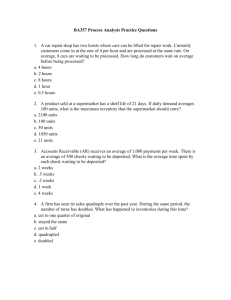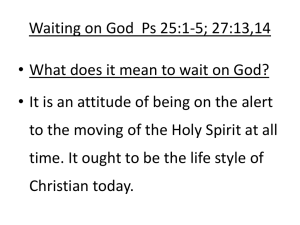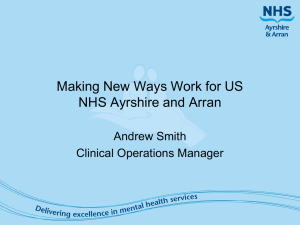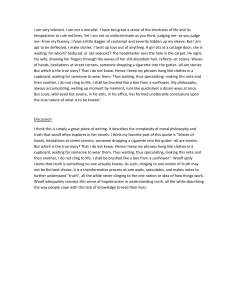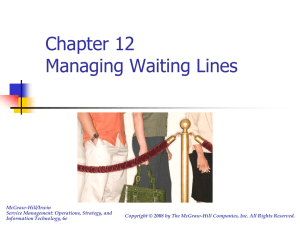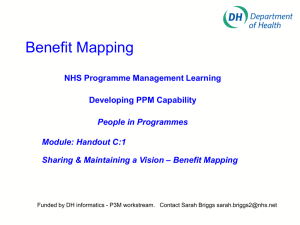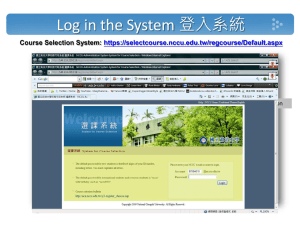Flow Variability & Safety Capacity: Chapter & Solutions
advertisement
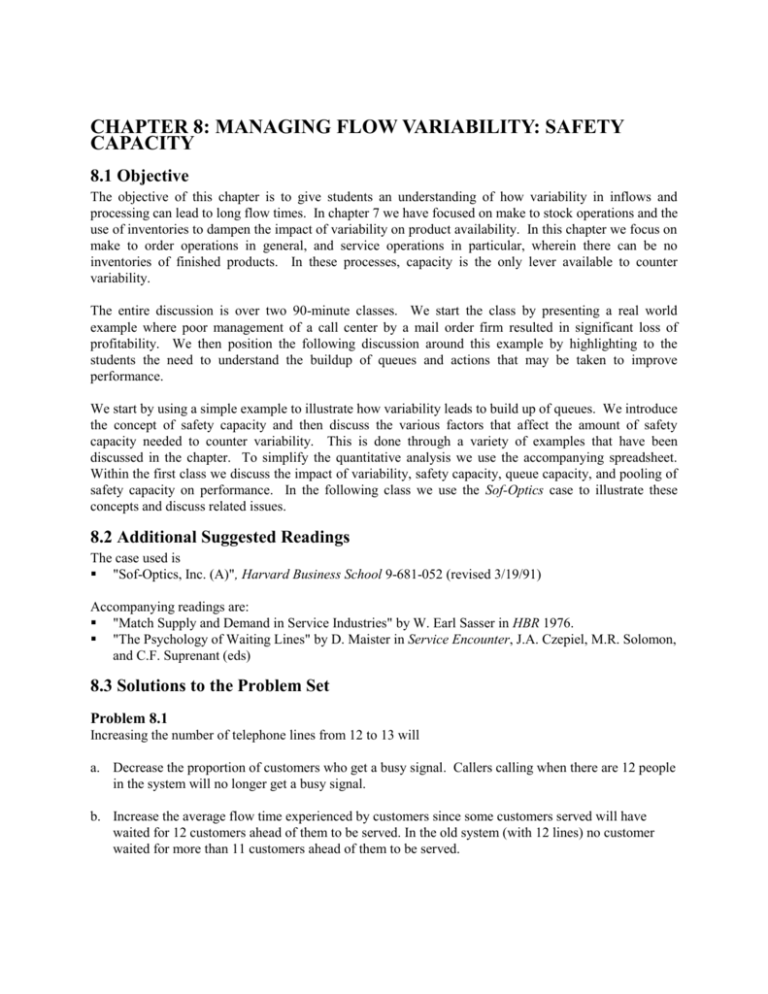
CHAPTER 8: MANAGING FLOW VARIABILITY: SAFETY CAPACITY 8.1 Objective The objective of this chapter is to give students an understanding of how variability in inflows and processing can lead to long flow times. In chapter 7 we have focused on make to stock operations and the use of inventories to dampen the impact of variability on product availability. In this chapter we focus on make to order operations in general, and service operations in particular, wherein there can be no inventories of finished products. In these processes, capacity is the only lever available to counter variability. The entire discussion is over two 90-minute classes. We start the class by presenting a real world example where poor management of a call center by a mail order firm resulted in significant loss of profitability. We then position the following discussion around this example by highlighting to the students the need to understand the buildup of queues and actions that may be taken to improve performance. We start by using a simple example to illustrate how variability leads to build up of queues. We introduce the concept of safety capacity and then discuss the various factors that affect the amount of safety capacity needed to counter variability. This is done through a variety of examples that have been discussed in the chapter. To simplify the quantitative analysis we use the accompanying spreadsheet. Within the first class we discuss the impact of variability, safety capacity, queue capacity, and pooling of safety capacity on performance. In the following class we use the Sof-Optics case to illustrate these concepts and discuss related issues. 8.2 Additional Suggested Readings The case used is "Sof-Optics, Inc. (A)", Harvard Business School 9-681-052 (revised 3/19/91) Accompanying readings are: "Match Supply and Demand in Service Industries" by W. Earl Sasser in HBR 1976. "The Psychology of Waiting Lines" by D. Maister in Service Encounter, J.A. Czepiel, M.R. Solomon, and C.F. Suprenant (eds) 8.3 Solutions to the Problem Set Problem 8.1 Increasing the number of telephone lines from 12 to 13 will a. Decrease the proportion of customers who get a busy signal. Callers calling when there are 12 people in the system will no longer get a busy signal. b. Increase the average flow time experienced by customers since some customers served will have waited for 12 customers ahead of them to be served. In the old system (with 12 lines) no customer waited for more than 11 customers ahead of them to be served. 2 c. Increase the server utilization since the same number of servers will serve more customers (since fewer are blocked). Problem 8.2 Merging the two departments will a. Decrease the proportion of callers getting a busy signal. b. Decrease the average flow time experienced by the callers. Problem 8.3 John Doe has promised a total service time of 20 minutes. The processing time at the oven is 15 minutes with 2 minutes for preparation. This leaves at most 3 minutes in waiting time before the pizza has to be given away for free. The average demand is anticipated to be 20 pizzas per hour. Since John plans to get 5 ovens (each with a capacity of 60/15 = 4 pizzas per hour) there is no safety capacity. Any variability in arrival rate (or service time) will lead to a build up of queues and waiting time in excess of 3 minutes, resulting in John giving up many free pizzas. Thus the potential partner should either get John to buy more ovens or get out of the business, or stop giving the service guarantee. Problem 8.4 (M. M. Sprout) a. We are given: Average arrival rate Ri = 1/4 per minute, Average unit capacity 1/Tp = 1/3 per minute, Number of servers c = 1. Using the Performance.xls spreadsheet, we get Server utilization u = Ri / Rp = 0.75, Average waiting time Ti = 9 mins, Average number of customers on hold Ii = 2.25, Average number of customers in the system I = 3. The costs include the CSR wages and the cost of waiting (line charge + waiting cost for customers). We have Hourly wages of CSR = $20 / hour, Line charge = $5 / hour (for all lines used), Customer waiting cost = Average number on hold60$2 = 2.25120 = $270. Hence, the total hourly cost = $20 + $5 + $270 = $295/hour. b. With only four lines and one CSR, we have Average arrival rate Ri = 1/4 per minute, Average unit capacity 1/Tp = 1/3 per minute, Number of servers c = 1, Maximum buffer size K = 3. Using the spreadsheet Performance.xls we get Average waiting time Ti = 3.45 mins, Average # of customers on hold Ii = 0.77, Average number of customers in system I = 1.44, Probability of blocking = 0.104. In this case the costs incurred are the CSR wages, the cost of waiting (line charge + waiting cost for customers) and the lost business because of blocked calls. We have Hourly wages of CSR = $20 / hour, Line charge = $5 / hour, 3 Customer waiting cost = Average number on hold60$2 = .77120 = $92.4, Cost of blocking = Calls blocked per hour$100 = Probability of blockingAverage arrival rate$100 = 0.10415$100 = $156. This implies that Total hourly cost = $20 + $5 + $92.4 + $156 = $273.4. c. Upon adding another telephone line, we have Average arrival rate Ri = 1/4 per minute, Average unit capacity 1/Tp = 1/3 per minute, Number of servers c = 1, Maximum buffer size, K = 4. Using the Performance.xls spreadsheet we get Average waiting time Ti = 4.33 mins, Average # of customers on hold Ii = 1.005, Average number of customers in system I = 1.70, Probability of blocking = 0.072. In this case the costs incurred are the wages of the CSR, the cost of waiting (line charge + waiting cost for customers) and the lost business because of blocked calls. We have Hourly wages of CSR = $20 / hour, Line charge (of existing lines) = $5 / hour, Customer waiting cost = Average number on hold60$2 = 1.005120 = $120.6, Cost of blocking = Calls blocked per hour$100 = Probability of blockingAverage arrival rate$100 = 0.07215$100 = $108. Excluding the cost of the new line we have Total cost per hour = $20 + $5 + $120.6 + $108 = $253.6. As long as the cost of the new line is less than $273.4 (cost with 4 lines) - $253.6 (cost with 3 lines) = $19.8 / hour, it pays to install the new line. d. Upon adding another server (assuming that the fifth line has been added) we have Average arrival rate Ri = 1/4 per minute, Average unit capacity 1/Tp = 1/3 per minute, Number of servers c = 2, Maximum buffer size K = 3. Using the Performance.xls spreadsheet we get Average waiting time Ti = 0.42 minutes, Average # of customers on hold Ii = 0.105 Average number of customers in system I = 0.85, Probability of blocking = 0.007. In this case the costs incurred are the wages of the CSR, the cost of waiting (line charge + waiting cost for customers) and the lost business because of blocked calls. We have Hourly wages of CSRs = $40 / hour, Line charge = $5 / hour, Customer waiting cost = Average number on hold60$2 = .105120 = $12.6, Cost of blocking = Calls blocked per hour$100 = Probability of blockingAverage arrival rate$100 = 0.00715$100 = $10.5. In this case we have Hourly cost of system = $40 + $5 + $12.6 + $10.5 = $68.1/hour. This is a significant reduction in cost. The new CSR should thus be hired. 4 Problem 8.5 (Heavenly Mercy Hospital) a. We have: Average arrival rate Ri = 18 per hour = 0.3 per minute, Average unit capacity 1/Tp = 2 per hour = 1/30 per minute, Number of servers c: To be determined, Cost per server = $100 per hour, Desired average time in system = 40 minutes. To plan staffing, we know that we should have a utilization of less than 100%, thus: Utilization = inflow/capacity = 18/hr/(c*2/hr) < 1 so that c > 9 Increasing the number of servers from 10 upward, we have the following results (using the Performance.xls spreadsheet with infinite queue): Number of Servers (c) 10 11 12 Avg. Number in System (I) 15 10.94 9.8 Avg. Time in System (T) 50 minutes 36.45 minutes 32.7 minutes Thus hiring 11 servers achieves a turnaround time of 36.45 minutes on average, which is under the desired target of 40 minutes. The hourly cost of this system is $1,100. b. Now consider the case where the service time is reduced to 20 minutes but the cost of the equipment and radiologist is $150 per hour. In this case: Average arrival rate Ri = 18 per hour = 0.3 per minute, Average unit capacity 1/Tp = 3 per hour = 1/20 per minute, Number of servers c: To be determined, Cost per server = $150 per hour, Desired average time in system = 40 minutes. To plan staffing, we know that we should have a utilization of less than 100%, thus: Utilization = inflow/capacity = 18/hr/(c*3/hr) < 1 so that c > 6 Increasing the number of servers from 7 upward, we have the following results: Number of Servers (c) Avg. Number in System (I) Avg. Time in System (T) 7 9.7 32.28 8 7 23.6 Hence, c = 7 is sufficient and the cost of hiring seven servers = 7150 = $1,050, which is lower than in part a. Thus it is advantageous to lease the more sophisticated equipment. It reduces the cost and reduces the overall time spent in the system. Problem 8.6 (First Local Bank) a. We currently have: Average arrival rate Ri = 30 per hour = 0.5 per minute, Average unit capacity 1/Tp = 10 per hour = 1/6 per minute, Number of servers c = 4, Cost of customer waiting = $20/hour = $1/3 per minute. Performance of the current system is (using Performance.xls) Average waiting time Ti = 3.06 mins, Average time in system T = 9.06 minutes, 5 Average # of customers on hold Ii = 1.53. We thus have Hourly cost of customer wait = Average number waiting$20 = 1.53$20 = $30.6 b. If the new equipment is leased with the same number of servers, we have Average arrival rate Ri = 30 per hour = 0.5 per minute, Average unit capacity 1/Tp = 15 per hour = 1/4 per minute, Number of servers c = 4. Performance of the new system is (using Performance.xls) Average waiting time Ti = 0.35 mins, Average time in system T = 4.35 minutes, Average # of customers on hold Ii = 0.17. We thus have Hourly cost of customer wait = Average number waiting$20 = 0.17$20 = $3.4, Hourly cost of high-speed equipment = $30 per hour. This implies that Total cost of new system = $33.4 per hour. This is somewhat higher than the total cost of the original system and cannot be justified in financial terms. However performance in terms of customer waiting is significantly improved with total time in system reducing from 9.06 minutes to 4.35 minutes. If the goal is to reduce average time in system below 8 minutes, the high-speed equipment is worth leasing. Problem 8.7 (Global Airlines) Average arrival rate, Ri = 52 per hour = 52/60 per minute, Average unit capacity, 1/Tp = 20 per hour = 1/3 per minute, Number of servers, c : To be determined, Cost of customer waiting = $1 per minute = $60/hour, Cost per server = $20 per hour. To plan staffing, we know that we should have a utilization of less than 100%, thus: Utilization = inflow/capacity = 52/hr/(c*20/hr) < 1 so that c > 52/20 = 2.6. Increasing the number of servers from 3 upward, we have: Number of Servers c 3 4 5 Server cost per hour Average Queue length Ii Average waiting time Ti Waiting cost per hour = Ii60 Total cost per hour $60 $80 $100 4.95 0.66 0.16 5.71 0.76 0.19 $297 $39.6 $9.6 $357 $119.6 $109.6 Thus Global should staff with 5 agents. Hiring a sixth agent will raise the agent cost to $120 per hour and is not worthwhile. The industry norm of averaging under 3 minutes of waiting can be achieved using only 4 agents. Problem 8.8 (Henniker Bank) a. For one district, Ri = 3.5 claims/week = 3.5/5 or 0.7 claims/day, and Tp = 1.2 days, so Rp = 1/1.2 = 0.833 claims/day. With c =1, T = 1/ (Rp – Ri ) = 7.5 days. From Little’s Law, the average number of 6 claims in the system (for one district) is 07 . 7 .5 5.25 . Out of those 5.25 - 0.84 = 4.41 will be waiting to be processed. The total number of claims across all districts is then 3 4.41 13.23 . Hence, utilization u = 0.7/0.833 = 0.84. 10 The fraction of claims that take less than 10 days is given by 1 e 7 .5 0 .736 . b. If we reduce the standard deviation of the service process by 50% but leave the mean unchanged, The total CS2 0.25 . We then have (for one district), Ii = u/(1- u claims. 10 across all districts is then 8.28. The fraction taking less than 10 days is 1 e 5 .14 0 .857 Problem 8.9.(Burrito King) a. Reducing variability will reduce the waiting time b. Server utilization will remain the same, since the average demand and service rates do not change. Problem 8.10 (V. V. Ranger) The average waiting time will decrease. Pooling of safety capacity pooling through one waiting line yields lower waiting times because idleness periods are re-distributed. Problem 8.11 (Master Karr) Part a b a. Arrival Rate Service Time # of Servers Buffer Capacity Ri Tp c K 4 4 1 1 5 6 Average Probability of Average Utilization blocking queue length u 10 9 79.00% 66.50% P(block) 1.25E-02 2.48E-03 II 1.58 0.51 Waiting cost = ($60/hr)*(average # of customers waiting) = $60 Ii = $94.65/hr Blocking cost = ($50/call)*(average # of busy calls/hr) = $50/call * R * P(block) = $149.93/hr Staffing cost = $15/CSR * (# of CSRs) = $15 c = $75/hr Total cost = $319.58/hr b. Now the number of servers c increases to 6 while the buffer capacity K decreases to 9. Re-calculate the performance with the spreadsheet (calculations above). Waiting cost = $60 Ii = $30.77/hr Blocking cost = $50/call * R * P(block) = $29.78/hr Staffing cost = $15 c = $90/hr Total = $150.54/hr Hence, we should add a server, as it yields a cost savings of $319.58 – $150.54 = $169.04 /hr. Problem 8.12 (BizTravel.com) a. This is the resource pooling idea in the context of one queue vs. multiple queue. With the CRM software, BizTravel will be able to meet its service guarantee better. 7 b. Now, average arrival rate equals the average service rate. This implies long queues and hence BizTravel will pay out $10.00 often during the lunch hour. Problem 8.13 (McBerger) a. The average waiting time in queue will decrease, because less variability leads to less waiting, by the queue length formula. b. The average waiting time in queue will decrease because shorter service time leads to lower capacity utilization and hence less waiting 8.4 Test Questions 8.4.1 A mail order firm has a total of 12 Watts lines coming into the customer service department (CSD), which has five customer service representatives. On average, two potential customers call CSD every minute. Each customer service representative requires on average 2 minutes to serve a customer. On one of the days two of the Watts lines happen to be down (as a result only 10 Watts lines are available that day). As a result, the mail order firm can expect that (a) The proportion of potential customers getting a busy signal will (i) (ii) (iii) Increase Decrease Remained unchanged (b) The average waiting time that customers experience will (i) (ii) (iii) Increase Decrease Remained unchanged (c) The average utilization of customer service representatives will (i) (ii) (iii) Increase Decrease Remained unchanged. Answers: (a) The proportion of potential customers getting a busy signal will increase, since the queue capacity has decreased (b) The average waiting time in queue will decrease since customers that are blocked from entering the process now are those that would have waited a long time when the lines were up. (c) The average utilization of customers will decrease since more are blocked and thus fewer are served. 8.4.2 A manufacturer of auto parts has just learnt about the Toyota production system and is trying to implement JIT. Traditionally there has been no control on the amount of work in process inventory between stages (it has been known to exceed 500 parts between some stages). As a first step the 8 amount of work in process inventory between stages is limited to a maximum of 20 parts. What, if any, impact does this have on the output from the factory on the short term? Answer: Limiting the maximum size of the buffer to 20 parts is equivalent to limiting the queue capacity. Reducing the queue capacity reduces the throughput. Thus, limiting the work in process inventory will lead to a reduction in the output from the factory. 8.4.3 A mail order company has one department taking customer orders and the other handling customer complaints. Currently each department has a separate telephone number. Each department has 7 Watts lines served by two customer service representatives. Calls come into each department at the rate of 1 per minute. Each customer service representative takes on average 1.5 minutes to serve a customer. A proposal has been put forward to merge the to departments and cross train the workers. The new department would, as a result, have 14 watts lines served by four customer service representatives. As the operations manager, you know that (a) The proportion of callers getting a busy signal will (i) (ii) (iii) Increase Decrease Remained unchanged. (b) The average utilization of customer service representatives will (i) (ii) (iii) Increase Decrease Remained unchanged Answers: (a) The proportion of callers getting a busy signal will decrease. Callers will now get a busy signal only if there are 14 people in the process. This is equivalent to having 7 people in each of the two previous processes. In the previous setup, some callers would get a busy signal if either of the two processes had 7 people. (b) The average utilization of customer service representatives will increase since more customers now enter the process and are served. 8.4.4 Star Brite Media (SBM), an independent video rental store, carries digital projection systems that customers can rent out together with new, high-definition DVDs. The store manager is forecasting that, in an average week, about 21 customers would ask to rent a projection system, the exact number of requests per week being random and may be assumed to be Poisson distributed. Their projection rental time is estimated to follow exponential distribution with a mean of about 3 days. (SBM is open 7 days per week.) a. What is the minimum number of projection systems Sandra should buy to ensure a service level of 90%, i.e., that the probability that a projection system is available when a customer requests to rent one is about 90%? (Assume that customers who are interested in renting a projection system but do not find one available do not wait, but go to find one at another store.) 9 Answer: Each projection unit may be considered to be a “server”. Since customers do not wait, if all servers are busy, a new arrival will be “blocked”. In Performnace.xls spreadsheet, enter the arrival rate = 21/week = 3/day, Processing time = 3 days, c = 12, K = 0. Changing the number of servers until it is 12 yields Pb=8.3%, the first time the blocking probability does not exceed 10%. Thus, the store should keep at least 12 projection systems. b. Instead of buying outright, SBM has the option of leasing the projection systems at a special rate of $199 per month per projection system. (This includes insurance on the systems.) What is the break-even price that SBM should charge per day for renting out a projection system? (Assume 30 days per month, an average rental length of 3 days, and a service level of 90%.) Answer: Each projector costs $199/month. From the spreadsheet, projector utilization = 0.6877, so on average, each projector is rented out (30)(0.6877) = 20.63 days in a month. To recover $199, on average, each projector must collect at least $199/ 20.63 = $9.64 per day. 8.4.5 Jasper Valley Motors (JVM) is a mid-sized, family-run auto repair shop. To assure customer satisfaction, JVM has kept a fleet of four “loaner” cars that customers may drive while their vehicles are being serviced. In an average week, 15.5 major repairs are scheduled for which owners request a loaner car (the service department is open five days per week). Of course, the exact number of loaner requests is random, and the time between requests may be assumed to be exponentially distributed. If a loaner car is not available when a customer needs one, JVM’s policy is to take $50 off the cost of the service as compensation for the customer inconvenience, as they must find alternate transportation to and from the shop. Most repairs are done within a day but some take longer, requiring the customer to keep the loaner car for several days. It has been observed that on average, a customer keeps a loaner car for 1.2 days, and the actual time may be assumed to be exponentially distributed. a. What is the probability that a customer who requests a loaner car from JVM will actually get one? Performance.xls Spreadsheet inputs: Ri = 3.1 request/day Service time = 1.2 days Servers = 4 Buffer = 0 (since customers do not wait for a loaner if one is not immediately available). Prob (Block) = 28.3%, hence, Prob (get car) = 1 – 0.283 = 71.7% b. What is the percentage utilization of JVM’s fleet of loaner cars? On an average day, how many loaner cars are on JVM’s lot (i.e., not loaned out to customers)? From Performance.xls, loaner car utilization = 66.68%, so (4)(0.668) = 2.67 cars are with customers. So 4 – 2.67 = 1.33 cars are on the lot.. c Suppose JVM leases the loaner cars from an automaker at a rate of $350 per month per car, which includes insurance. Max estimates that it costs $12 per “loaner”, which covers the cost of the necessary paperwork when the car goes out as well as cleaning the car when it is returned. What are JVM’s monthly costs of running the loaner car program (including discounts to those who do not receive loaners)? Assume 20 days in a month. With Prob(Blocking) = 0.283, number of cars loaned out per day = (3.1)*[1- Pr(Block)] = 2.22 or 44.46 loaners/month Discount compensation per day = (3.1) * [Pr(Block)] = 0.88 or 17.54 discounts/month 10 Hence, compute costs: Loan variable cost = (44.46) * (12) = $533.47/month Discounts = (17.54) * (50) = $877.2/month Lease = (4)* (350) = $1400/month Total Cost = $2810.67/month 8.4.6 According to the Wall St Journal, research has shown that women take about twice as long in public restrooms as men (roughly, 3 minutes to 1.4 minutes). It is therefore not surprising that waits at the women’s restrooms are generally longer than at the mens’. As a consequence, many states have passed so-called Potty Parity Laws. (A Google search on “potty parity” yields over 300 results.) These laws aim to equalize waiting line lengths for restrooms at public facilities such as theaters and convention halls. Laws in Maryland and New York mandate an equal number of toilets for men and women (older facilities generally had more men’s rooms). Other states mandate more toilets for women. For example, California requires a 4 to 1 ratio. a. Assuming that a typical facility serves an equal number of men and women, would you expect the Maryland and New York legislation to be adequate in delivering equal waiting lines? Why? Answer: Inadequate, since the processing times are longer, you need more capacity for ladies b. The Colorado Convention Center in Denver has dealt with potty parity by installing movable walls between the men’s and women’s rooms. Capacity is allocated based on the make up of the group using the facility. Thus when a largely female group is in town, the women’s room is allocated up to 75% of capacity. When a largely male group is having a meeting, the men’s room gets up to 75% of capacity. What are the benefits of this approach? How does it compare to supply chain management techniques we discussed in class Answer: Flexibility allows them to use the available capacity more effectively. This is equivalent to pooling or aggregation of stocks in supply chain management 8.4.7 Mateo is COO of the company We-Do-Your-Taxes (WDYT). WDYT typically prepares taxes for physicians in three steps: step 1 involves a customer service representative (CSR) talking with a customer physician and receiving all relevant financial information (pay stubs, expenses, etc.); in step 2 another employee takes all the data from the CSR and fills out all relevant tax statements. Finally, in step 3, a third employee compiles all tax statements, and does a final quality check for completeness and mails out the tax statements to the governmental agency (the IRS) and a copy to the customer. Mateo is considering restructuring the WDYT business process around a “single-point-ofcontact” in which a single employee would perform all three tasks of a customers tax preparation and filing. a. What are the benefit(s) and disadvantage(s) of the single-point-of-contact process and why? 11 Benefits: 1. The pooled safety capacity of all servers is now available to all customers while in the serial system some server may idle while others are busy. 2. Breaking up serial dependencies: in the pooled system a customer’s flow time is less dependent on its predecessors’ (long jobs keep one server busy, while shorter jobs are processed by another parallel server) while in the serial system there is full serial dependency. (This benefit is more subtle than simple pooling of safety capacity.) 3. No more blocking or starvation (recall match game = the serial game). Clear responsibility, incentive alignment and customer-ease of single-point-of-contact. Disadvantages: We are going against Adam Smith: generalists typically will lose specialization benefits, resulting in service times that exceed the sum of service times of specialists b. Mateo is also considering “Plan G” (G for growth) to expand the business by going after a more diversified clientele. Under Plan G, WDYT would also serve other professionals, including small business owners, in addition to the current customer base of physicians. Under Plan G, Mateo would authorize more hiring and expand capacity proportional to the increase in business (in terms of number of taxes prepared per month). How would Plan G impact the quality of service in terms of responsiveness ? Answer: There are actually two possible answers here: Effect 1: Plan G calls for more heterogeneity, meaning more variability. If we keep utilization constant, waiting will still increase. Effect 2: Plan G also increases capacity, i.e. adds servers. Now, even with utilization constant, adding servers, allows better pooling of safety capacity and will decrease waiting. Bottomline: depends on which effect (1 or 2) dominates.

